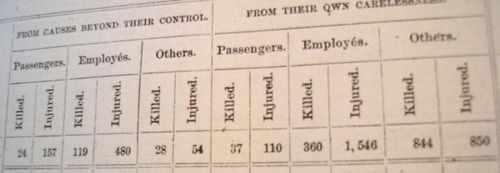JF Ptak Science Books LLC Post 415
Searching for something entirely unrelated to what I found (trying to answer how straight railway tracks were in Texas in 1880*) but happy with the stumbling is this header for a long list of railway deaths on American railroads in the year 1880. It appears in on page 280, part VIII, volume 13, part 4 of the U.S. House Miscellaneous Documents No. 42, part 4, volume 2132 of the publications of the U.S. House of Representatives. Lots of numbers, yes? Actually it is just vol 13 of the U.S. census report for 1880, the Statistical Report of the Railroads in the United States, by Armin E. Shuman ("Expert"). It si a big books in a series of big books, running 862 pages and is mostly just (beautiful) numbers. It is remarkable, really, that these folks had such extraordinary control over this amount of data--not only were they collecting it, but analyzing it as well, and doing it before the big breakthroughs that would come in the next census with the Hollerith machines.
 The table is a summary of accidents reported by all railroads in the United States for the year 1880. For *one* year, not the decade of the 1870's. The short story is that 2,541 people were killed in/on/by trains, with 5,674 injured. Of the "killed" number, 61 were passengers who were killed "from causes beyond their control", and 62 were killed "from their own carelessness". The numbers get much bigger because of the number of employees killed on the job, more than 900 in the one year alone. The total number of passengers carried for the year was 269,000,000. I cannot find the number o total miles traveled.
The table is a summary of accidents reported by all railroads in the United States for the year 1880. For *one* year, not the decade of the 1870's. The short story is that 2,541 people were killed in/on/by trains, with 5,674 injured. Of the "killed" number, 61 were passengers who were killed "from causes beyond their control", and 62 were killed "from their own carelessness". The numbers get much bigger because of the number of employees killed on the job, more than 900 in the one year alone. The total number of passengers carried for the year was 269,000,000. I cannot find the number o total miles traveled.
I made a quick check on the Bureau of transportation Statistics website just to see what kind of similarities there might be in these numbers. It turns out that the gross numbers were sort of similar--there were 658,000,.000 passengers carried domestically by American carriers in 2006. There was a tremendous difference in deaths, though: 47 people were killed as a result of air travel that year, compared with the 2,541 by trains in 1880. Two orders of magnitude, about, with each person traveling a great distance in the air (averaging about 1000 miles) than by rail (whose numbers I could not find quickly). It is kind of interesting, though, that when you consider passengers as a lone stat in 1880 that the numbers get very close to 2006.
Working on the railroads in 1880 was tough and dangerous--more dangerous than I had known. And I can pretty well guess that there were no Thanksgiving turkeys being delivered to anyone's family if Father happened to get cut in half by the South Manchester Railroad Company. Certainly no turkey would come the year after.


John, I have read other sources which describe the raw numbers of employees (that was, by far, the largest category of deaths) who died in that era, serving the only transportation system then in existence. One can argue for other, far-less-used transport, but it would not be an argument bearing much weight.
While it would hardly constitute good news, at least that family who suffered the loss of the bread-winner member of the family to an unintentional bifurcation would be presented with all the parts for proper burial. Or, so one can imagine.
Posted by: Rick Hamrick | 09 December 2008 at 09:57 AM